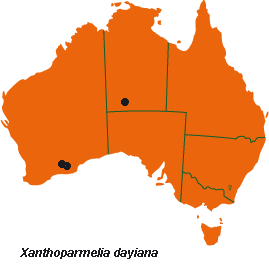



Australian Biological Resources Study
| Checklist of the Lichens of Australia and its Island Territories | ||
| Introduction | A–D | E–O | P–R | S–Z | Oceanic Islands | References | ||
| Xanthoparmelia dayiana (Elix & P.M.Armstr.) Elix & J.Johnst. | ||
| in J.A.Elix, J.Johnston & P.M.Armstrong, Bull. Brit. Mus. (Nat. Hist.), Bot. 15: 225 (1986); Parmelia dayiana Elix & P.M.Armstr., Austral. J. Bot. 31: 468 (1983). T: near Kalgoorlie, W.A., June 1982, M.F.Day; holo: MEL. | ||
| Thallus subcrustose, tightly adnate, to c. 2–3 cm wide. Lobes not imbricate, discrete at thallus periphery, flat, subirregular to sublinear, irregularly branched, 0.5–1 mm wide. Upper surface pale yellow-green, dull, emaculate, without soredia; older lobes irregularly cracked and becoming areolate; isidia numerous, globose becoming subcylindrical, branched or not, becoming inflated at apices; isidia apices epicorticate and erumpent but not sorediate. Medulla white. Lower surface pale brown to brown; rhizines moderately dense, simple, concolorous. Apothecia and pycnidia not observed. CHEMISTRY: cortex K-, UV-; medulla K- or K+ faint brown, C-, P+ orange-red; containing usnic acid, fumarprotocetraric acid, succinprotocetraric acid and protocetraric acid (trace). |  |
|
| Rare, endemic, on exposed rock in inland W.A. and N.T. | ||
| Elix (1994z) | ||
| Checklist Index |
| Introduction | A–D | E–O | P–R | S–Z | Oceanic Islands | References |
This work is copyright. Apart from any use as permitted under the Copyright Act 1968, no part may be reproduced by any process without prior written permission from Australian Biological Resources Study. Requests and inquiries concerning reproduction and rights should be addressed in the first instance to Dr P. McCarthy. These pages may not be displayed on, or downloaded to, any other server without the express permission of ABRS.